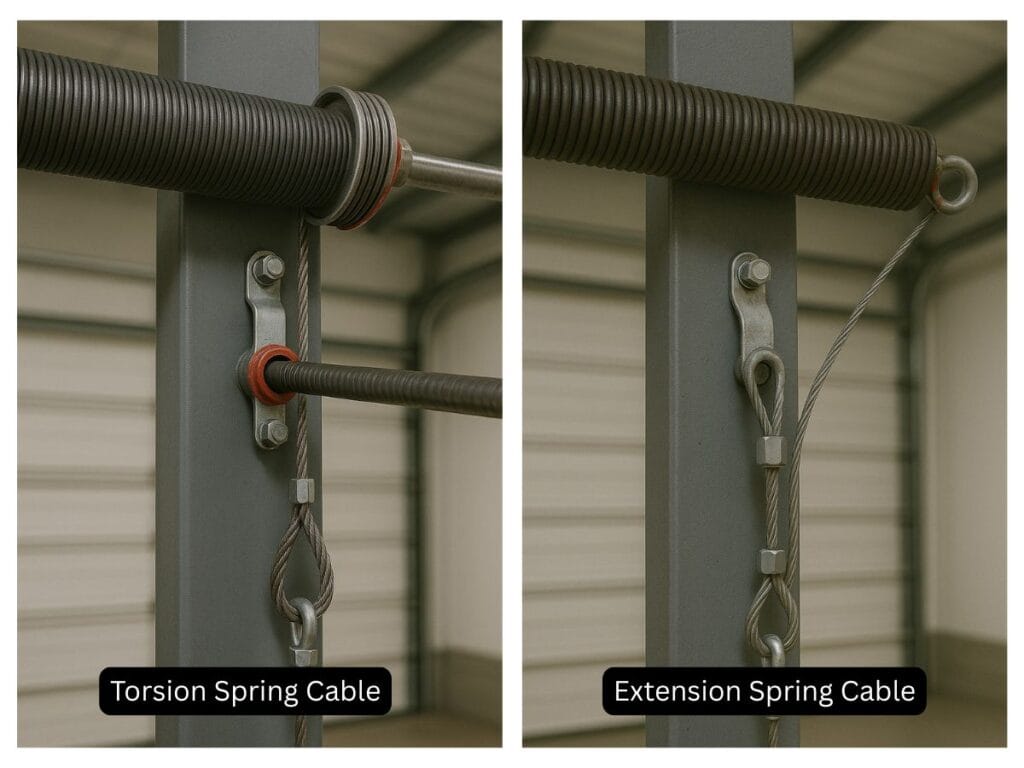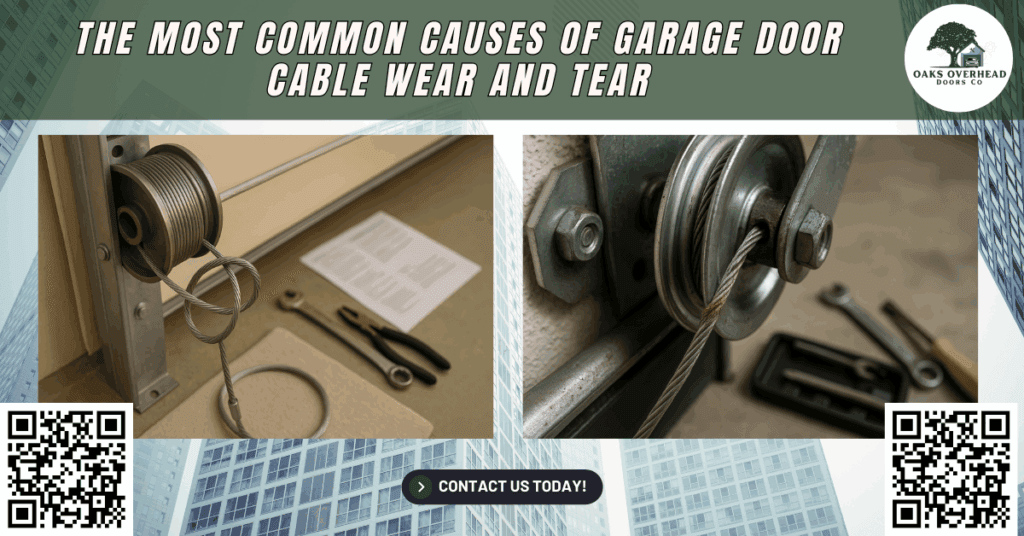When a Houston family recently called Oak Forest Garage Doors early one morning, it was clear something had gone wrong. Their brand-new garage door opener system had suddenly stopped mid-operation. The door was stuck halfway, and nothing they tried could move it. Our technicians arrived quickly and discovered the problem: a broken garage door cable that had slipped off the cable drum, throwing off the entire garage door system. Thankfully, no one was hurt, but the incident reminded us how crucial it is to understand and maintain every part of a modern garage system, especially the cables.
Did you know that garage doors, particularly ones with torsion springs and modern openers, can weigh between 130 to over 300 pounds? That’s a lot of weight suspended over your car or your family. Without strong, properly tensioned garage door cables, your door could come crashing down. That’s why regular garage door maintenance, especially garage door cable replacement, is key to keeping your home safe and your garage door operating smoothly.
At Oak Forest Garage Doors, we specialize in residential and commercial garage door services, including cable replacement, repairs, and full system upgrades across Houston, TX. In this article, we’ll give you a step-by-step guide to understanding your garage door cables, why they fail, and how to handle cable replacement with professional help when needed.
What Are Garage Door Cables and Why Are They Important?
Garage door cables are essential components that work alongside springs, either torsion or extension springs, to lift and lower the door with ease. They are made from heavy-duty steel wire, capable of handling high-tension forces. These cables ensure that the heavy garage door can be raised and lowered smoothly, evenly distributing the load to prevent jerky movements and potential accidents.
Types of Garage Door Cables
- Torsion Spring Cables
These are used with torsion spring systems. The cables wrap around a cable drum located near the top of the garage door. When the garage door opener is activated, the torsion tube rotates, pulling the cables and lifting the door. These cables are common in modern garage systems, which prioritize durability and efficiency. - Extension Spring Cables
These are found in older garages or lighter doors. They stretch alongside the horizontal track and use pulleys to counterbalance the weight. While not as common today, they still exist in many homes and require the same level of care and maintenance.

Why They Matter
Without properly functioning door cables, the entire garage door system can become unsafe. Cables bear much of the door’s weight during movement. If a garage door cable breaks, it can cause the door to fall suddenly, leading to serious injury, damage, or expensive repairs. The cables also play a critical role in maintaining the door’s alignment, preventing unnecessary stress on other components like the garage door springs, openers, and track system.
Common Causes of Garage Door Cable Failure
Garage door cables are tough, but they don’t last forever. Understanding what causes cable issues can help you prevent them and take action before a complete failure occurs.
1. Wear and Tear Over Time
Just like any moving part, garage door cables wear out with repeated use. Over time, the steel wires can fray, corrode, or snap under pressure. Daily cycles of opening and closing exert stress that gradually weakens the cable’s structural integrity.
2. Rust and Moisture Exposure
In humid climates like Houston, rust is a common issue. When cables corrode, their strength diminishes, increasing the risk of failure. Moisture can also cause the steel wires to stick and seize up, creating uneven tension during operation.
3. Improper Installation
If your garage door was installed without the correct spring tension or the cables weren’t aligned properly on the drums, it can lead to premature wear. This includes incorrect winding or choosing cables that are the wrong length or gauge.
4. Damaged Pulleys or Cable Drums
Worn pulleys or cable drums can cause cables to slip, twist, or jam. These components must be inspected regularly as part of your garage door maintenance routine. Damaged drums can also shred cable surfaces, accelerating wear.
5. Lack of Maintenance
Neglecting regular garage door maintenance can lead to an accumulation of dust, dirt, and grime that damages the cables. A lack of lubrication in moving parts also contributes to strain and early failure.
Signs You Need Garage Door Cable Replacement
How do you know when it’s time to replace your garage door cables? Watch for these warning signs:
- Frayed or loose cables near the bottom bracket
- The door appears crooked or off-track during operation
- You hear snapping sounds or feel resistance when using the door
- The garage door is stuck halfway or won’t open at all
- One side of the door drops faster than the other
- A visible broken cable hanging from the side of the door
These symptoms should never be ignored. Continuing to use your garage door in this condition could cause further damage or put your family at risk. In extreme cases, the door could fall entirely off the track, damaging your property or causing severe injury.
The Role of Cables in a Modern Garage Door System
Modern garage doors are more than just panels on rollers. They are sophisticated systems that rely on tension, precision, and balance to function efficiently.
Key Components Involving Cables
- Torsion Tube: This is where torsion springs mount and turn the cable drums. It stores mechanical energy and helps lift the door with ease.
- Cable Drum: This part winds the cable smoothly and keeps the door level during movement. It ensures the cable doesn’t unwind chaotically.
- Bottom Brackets: Where cables attach at the base of the door. These are under high tension and should never be adjusted without proper tools.
- Pulley System: In extension spring setups, pulleys help redistribute weight and ensure a smooth lift.
Each part must work in harmony. A worn spring, misaligned drum, or damaged bracket can throw off the garage door tension and lead to system failure. Modern systems are designed to maximize safety and reduce wear, but only if all parts are properly maintained.
Tools and Safety Gear Needed for Cable Replacement
Before attempting any work on your garage door cables, it’s essential to gather the right tools and personal protective equipment (PPE). This is not a typical handyman task, it requires caution and precision.
Tools
- Winding bars
- Vice grips
- Socket wrench set
- Safety glasses
- Work gloves
- Clamps
- Ladder
- Tape measure
- Replacement cables (compatible with your system)
- Lubricant (for moving parts)
Safety Precautions
- Always unplug the garage door opener before beginning.
- Wear safety glasses, steel-toed boots, and thick gloves.
- Never attempt to remove torsion springs or cables without training.
- Secure the door with C-clamps or locking pliers to keep it from moving.
- Keep children and pets away from the work area.
Even with the right tools, garage door repairs involving cables and springs are extremely dangerous due to high tension. DIY work could lead to serious injuries if something slips or fails unexpectedly.
Step-by-Step Guide: Replacing Garage Door Cables
Note: This guide is for educational purposes. For safe and reliable service, always call a professional technician like those at Oak Forest Garage Doors.
Step 1: Disconnect Power and Secure the Door
Turn off the garage door opener. Clamp the door in place using vice grips or C-clamps just above the rollers on both sides to prevent accidental movement.
Step 2: Release Tension from the Springs
Using winding bars, slowly and carefully release tension from the torsion springs. This process must be done with caution, as these springs can cause serious injury if mishandled.
Step 3: Remove Old Cables
Unwind the old cable from the cable drum and detach it from the bottom bracket. Inspect for wear, rust, and damage as you go.
Step 4: Install New Cable
Attach the new cable to the bottom bracket, feed it through the drum, and make sure it’s seated properly in the grooves. Repeat the process for both sides.
Step 5: Reapply Tension and Test
Once the new cables are installed, reapply tension to the springs using your winding bars, making sure everything is balanced. Test the door manually for smooth operation before reconnecting the power.
Why You Should Hire a Professional for Garage Door Cable Replacement
Replacing garage door cables is not your average weekend DIY project. It involves:
- High-tension springs that can snap if mishandled
- Complex systems with exact specifications
- Risk of injury or damage to your property
- The need for specialized tools and safety procedures
A professional garage door technician has the training and experience to do the job safely and efficiently. They can also inspect the entire system, including the garage door springs, drums, rollers, and opener,s to ensure nothing else is at risk of failure. Technicians from Oak Forest Garage Doors are equipped with industry-approved tools, follow all safety standards, and provide warranties on their work.
Preventive Maintenance Tips for Longer Cable Life
Routine garage door maintenance is your best defense against surprise repairs and emergency failures.
1. Inspect Cables Regularly
Look for fraying, corrosion, or rust on your cables at least once every season. Early detection can prevent more costly repairs.
2. Lubricate Moving Parts
Use a garage door-safe lubricant on the drums, springs, and pulleys to reduce wear and ensure smooth operation.
3. Schedule Annual Service
Let a trained technician do a full system check, including cable condition, spring tension, and bracket wear. Professionals can spot problems you might miss.
4. Avoid Excessive Manual Operation
Use your garage door opener to avoid unnecessary wear on the cables and springs. Avoid slamming the door or jerking it manually.
By investing in preventive maintenance, you extend the life of your garage door cables and ensure safe operation year-round. It also helps you avoid disruptions to daily routines and protect the value of your home.
Final Thoughts
Your garage door is one of the largest and most-used moving parts in your home. Whether you’re pulling in after work, letting the kids ride their bikes, or opening it for a delivery, you rely on it every day. That’s why keeping your garage door cables, springs, and other components in top condition is critical for your family’s safety and your home’s reliability.
Don’t wait for a broken cable to leave your car trapped or cause a serious accident. Stay alert for the signs, schedule regular inspections, and act early. With the right maintenance and a trusted professional by your side, you can count on your garage door system to perform safely and smoothly for years to come.
How Can Oak Forest Garage Doors Help You?
At Oak Forest Garage Doors, we’re proud to serve Houston, TX, and the surrounding areas with expert-level garage door repair, installation, and maintenance services. Our trained technicians handle all aspects of garage door cable replacement, from identifying worn components to performing precise repairs using high-quality parts.
We specialize in:
- Garage door cable replacement and tension adjustment
- Broken spring repair and replacement
- Full system inspections and preventive maintenance
- Garage door opener installation and upgrades
- Custom garage door installation and repairs
We’ll treat your home like our own—providing fast, reliable, and affordable service you can trust.
📍 Visit us at: 7265 W 43rd St, Houston, TX 77018, United States
📞 Call us today at: (281) 867-6660
Your safety is our priority. Let Oak Forest Garage Doors be your trusted partner for all things garage door.
Frequently Asked Questions (FAQs)
1. How long do garage door cables typically last?
Garage door cables usually last 7 to 10 years with regular use and proper maintenance, though high-cycle usage may shorten their lifespan.
2. Can you replace just one cable, or should both be replaced at the same time?
It’s best to replace both cables at the same time to ensure balanced operation and prevent uneven wear.
3. Are there different thicknesses of garage door cables?
Yes, cables come in various thicknesses (gauges) depending on the door’s weight and spring type, and using the wrong size can affect safe operation.
4. Will a broken garage door cable affect the garage door opener?
Yes, a broken cable can strain the opener or cause it to stop functioning, to prevent damage or unsafe operation.

